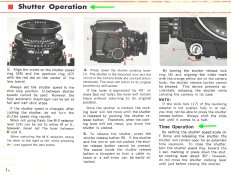ChristopherCoy
Subscriber
With regards to the "T" or time settings on the RB67 lenses - is there no other way to close the shutter besides having to cover the front element and use the shutter cocking lever?
I've been watching a particular photographer on youtube, and when doing a long exposure, he uses the shutter cocking lever on the side of the camera to close the shutter. As a safeguard he covers the front element with his hand to prevent any blurring. Is there no other way to close the shutter? Shouldn't it just close when you let go of the cable release?
Or is "T" not the same as "bulb"?
I've been watching a particular photographer on youtube, and when doing a long exposure, he uses the shutter cocking lever on the side of the camera to close the shutter. As a safeguard he covers the front element with his hand to prevent any blurring. Is there no other way to close the shutter? Shouldn't it just close when you let go of the cable release?
Or is "T" not the same as "bulb"?









